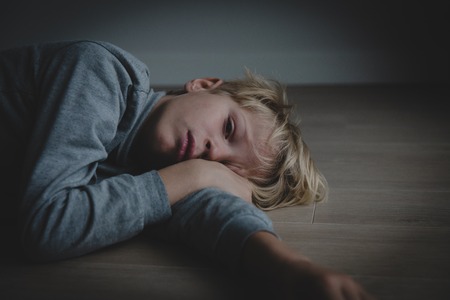Understanding Nightmares in British Children
Nightmares are a universal part of childhood, yet the way they manifest and are expressed can be deeply influenced by cultural context. For British children, nightmares often emerge as vivid, sometimes bewildering nocturnal episodes that interrupt sleep and provoke emotional distress. But what exactly constitutes a nightmare for youngsters growing up in the UK? Typically, these disturbing dreams involve scenarios of being chased, feeling lost, or encountering fantastical threats — think classic British folklore figures or even anxieties shaped by local urban legends. What’s particularly interesting is how British children describe their nighttime fears: language steeped in colloquialism, references to familiar settings like the local park or school playground, and sometimes a uniquely dry sense of humour when recounting their experiences the next morning. Understanding these cultural nuances not only helps to identify what triggers nightmares in British youth but also provides insight into how they process and communicate fear. This sets the stage for a more nuanced approach to supporting children through these unsettling nighttime experiences.
2. Common Causes of Nightmares
Nightmares in British children can arise from a complex interplay of psychological, developmental, and cultural factors. Understanding the origins of these unsettling dreams is crucial for parents seeking to provide effective support. Below, we examine a spectrum of causes that range from universal childhood experiences to distinctly British societal influences.
Developmental Milestones and Emotional Growth
As children progress through various stages of development, their brains process vast amounts of new information daily. This cognitive and emotional growth can often manifest as vivid dreams or nightmares, especially during periods such as starting school, losing a first tooth, or developing language skills. These milestones may provoke anxiety, excitement, or confusion—all emotions that can trigger night-time disturbances.
Family Stress and Environmental Changes
British families today face a range of stressors that may filter down to children. Divorce, bereavement, or even the arrival of a new sibling can unsettle a child’s sense of security. Additionally, changes like moving house or adjusting to new routines after school holidays are common sources of anxiety within UK households. The table below summarises some typical familial triggers:
Family Situation |
Potential Nightmare Trigger |
|---|---|
| Divorce or separation | Fear of abandonment; loss of stability |
| Bereavement (e.g., death of grandparent) | Anxiety about mortality; sadness |
| Relocation to new home/school | Uncertainty; fear of unfamiliar environments |
| Addition of sibling | Jealousy; feeling overlooked |
Unique British Societal Triggers
Cultural context plays an influential role in shaping childrens dreams. In Britain, certain experiences are more prevalent than elsewhere and may seep into the subconscious minds of young people. For instance, exposure to classic British folklore—think tales about the bogeyman or ghost stories told during Bonfire Night—can be both enchanting and frightening. Furthermore, national events such as football tournaments or royal celebrations might generate excitement mixed with anxiety, which could surface as nightmares.
The Role of Media and Popular Culture
The omnipresence of British media also deserves mention. Whether it’s dramatic weather reports on the BBC or news about national strikes and public protests, children may absorb these anxieties indirectly from adult conversations or television programmes. Even seemingly innocuous elements like Doctor Who monsters or pantomime villains can spark night-time fears unique to growing up in Britain.

3. Cultural Meanings and Attitudes
When it comes to nightmares, the British cultural lens offers a fascinating blend of tradition, storybook lore, and modern attitudes towards sleep. Folklore has long played a part in shaping how nightmares are understood—consider the infamous “Old Hag” myth, where an evil spirit is said to sit on one’s chest during troubled sleep, or tales of mischievous fairies causing unrest at night. These stories, while now recounted with a sense of nostalgia or humour, once provided both explanations and coping mechanisms for night terrors among children.
British children’s literature continues this tradition, weaving unsettling dreams into narratives that help young readers process their fears. Classic stories like Roald Dahl’s “The BFG” introduce the concept of dream-catching giants, gently demystifying nightmares by turning them into tangible entities that can be confronted or even befriended. Likewise, the works of Lewis Carroll and C.S. Lewis play with surreal dreamscapes, subtly conveying that strange nocturnal experiences are not only normal but can be gateways to creativity and self-discovery.
On a societal level, attitudes towards sleep and emotional wellbeing have evolved considerably in the UK. While there may still be a lingering British ‘stiff upper lip’ approach—where children are encouraged to brush off bad dreams as part of growing up—there is increasing recognition of the importance of talking openly about worries and anxieties. Schools often include discussions about feelings and mental health in their curriculum, reinforcing the idea that nightmares are a natural response to stress or change rather than something shameful or trivial.
This cultural backdrop influences parental responses too. Many British parents today balance traditional advice (“have a warm glass of milk”, “leave a night light on”) with more contemporary approaches such as mindfulness exercises or open conversations about emotions. Ultimately, the British context provides a unique patchwork of superstition, storytelling, and pragmatism—a blend that shapes how children and their families interpret and manage nightmares within everyday life.
4. The Impact of Media and Technology
In our digital age, the nightly landscape of children’s dreams is increasingly influenced by the media they consume. For British children, television programmes, social media platforms, and popular children’s books play a significant role in shaping both their imaginations and their anxieties. Let’s unpack how these cultural elements may contribute to the frequency and nature of nightmares among young people in the UK.
British Television: From Classic Series to Modern Streaming
Children’s TV in Britain has long been a double-edged sword. While shows like Blue Peter or The Clangers foster creativity and curiosity, others—think of certain episodes from Doctor Who or Grizzly Tales for Gruesome Kids—introduce themes that can easily seep into a child’s dreamscape. The advent of streaming means children can access content at any hour, often with less parental oversight than in previous generations.
| Media Type | Potential Nightmare Triggers | Typical Parental Response (UK) |
|---|---|---|
| Television (e.g., BBC, ITV) | Scary creatures, suspenseful music, unexpected plot twists | Co-watching, setting viewing limits |
| Streaming Services (Netflix, iPlayer) | Binge-watching unfamiliar shows, exposure to older content not age-rated | User profiles, content restrictions |
| YouTube & Social Media | User-generated horror stories, viral urban legends (e.g., “Momo Challenge”) | Parental controls, discussing online safety |
| Children’s Books (e.g., Roald Dahl) | Mischievous villains, dark humour, magical misfortune | Bedtime reading rituals, gentle debriefing after scary stories |
The Role of Social Media: Viral Fears and Shared Stories
Unlike traditional media, social networks spread fears quickly through peer sharing. Urban legends or “creepy challenges” circulate on platforms like TikTok or WhatsApp. British schoolchildren are not immune—playground chatter about a trending ghost story can easily escalate into collective anxiety.
Cultural Nuance: British Storytelling Tradition Meets Digital Age
The UK boasts a rich history of storytelling—from classic fairy tales to modern fantasy novels—where darkness often intermingles with whimsy. Today’s digital platforms amplify these narratives but also strip away some of the comforting context provided by parents or teachers. Without this buffer, frightening imagery or unresolved plotlines encountered online can linger in young minds as vivid nightmares.
A Cross-Disciplinary Perspective: How Parents Can Respond Effectively
Navigating this new terrain requires more than just technological solutions; it calls for open communication and culturally informed guidance. Parents might choose to co-view challenging content and use it as an opportunity for discussion. Encouraging children to express their feelings about what they see—and relating it back to familiar British cultural references—can help demystify the night terrors born from screens and pages alike.
5. Guidance for Parents: Practical Support and Conversations
Understanding the British Context
Supporting children through nightmares requires sensitivity to both emotional needs and cultural context. In the UK, open yet understated conversations are often valued, and many parents find reassurance in knowing they’re not alone—nightmares are a common part of childhood development. Recognising this, British parents can benefit from tapping into local resources and adopting communication approaches that resonate with their family’s values.
What to Say: Gentle Reassurance, Not Dismissal
It’s tempting to brush off a child’s bad dream with “Don’t worry, it was just a nightmare,” but a more effective approach is to acknowledge their feelings. Phrases like “That must have felt really scary” or “Would you like to talk about what happened?” offer validation and encourage openness. A typically British touch is to use gentle humour if appropriate—sometimes, imagining a nightmare villain in silly pyjamas can help defuse fear.
How to Listen: Attentive Presence
Active listening is key. Sit down with your child, maintain eye contact, and give them your full attention. Let them lead the conversation without rushing to solve the problem. The British tradition of a comforting bedtime routine—perhaps a warm drink (like decaf tea or hot milk) and a familiar story—can create a safe space for these discussions. Avoid interrogation; instead, listen with patience and empathy.
Practical Tips Rooted in Local Support Networks
- Leverage School Support: Many UK primary schools have pastoral care teams or school counsellors available. Don’t hesitate to reach out if nightmares persist or begin affecting daytime behaviour.
- Utilise NHS Resources: The NHS website offers guidance on sleep and mental health for children. Your GP can also provide support or referrals if needed.
- Connect with Local Parenting Groups: Organisations like NCT (National Childbirth Trust) or local council-run parenting workshops can be invaluable for sharing experiences and strategies.
Cultural Considerations
The British value privacy but also community. It’s completely normal—and often helpful—to discreetly seek advice from trusted friends or family members who’ve faced similar challenges. Remember, fostering resilience doesn’t mean ignoring distress; it means helping children feel heard, safe, and equipped to face their fears—one night at a time.
6. When to Seek Professional Help
While occasional nightmares are a normal part of childhood, particularly during periods of change or stress, there are situations where professional intervention may be necessary. Recognising the difference between typical bad dreams and those that signal deeper concerns is crucial for parents and carers in the UK.
Identifying Concerning Patterns
If your child’s nightmares persist for several weeks, occur multiple times a week, or significantly disrupt their sleep routine and daytime functioning, it may be time to consult a professional. British healthcare guidelines suggest that frequent sleep disturbances leading to mood changes, persistent anxiety, or avoidance behaviours (such as refusing bedtime or being unable to sleep alone) should not be ignored.
Warning Signs for Parents
- Nightmares are accompanied by symptoms of depression or severe anxiety.
- Your child expresses distressing or unusual themes in their dreams, such as ongoing fears of harm or loss.
- There is evidence of trauma, bullying at school, or significant life upheaval.
- Your child’s academic performance or social relationships begin to suffer.
Where to Turn for Support
In the UK, your first port of call can be your GP (General Practitioner), who can assess whether referral to a child psychologist, counsellor, or CAMHS (Child and Adolescent Mental Health Services) is appropriate. School pastoral teams and educational psychologists can also offer support if nightmares impact learning or behaviour at school. Remember, seeking help early can prevent escalation and provide both you and your child with effective strategies for managing nightmares and any underlying issues.


